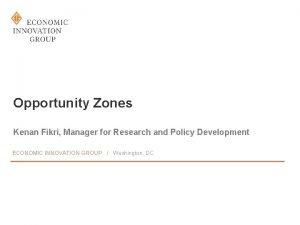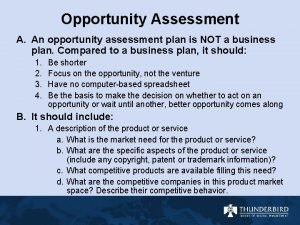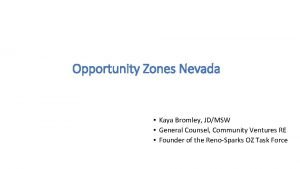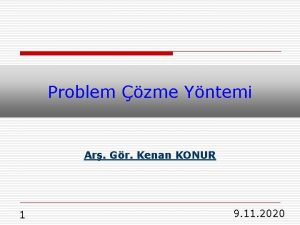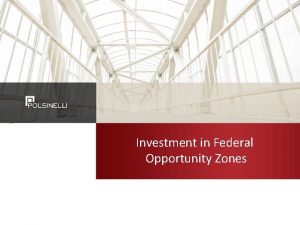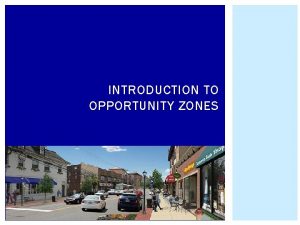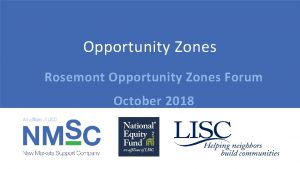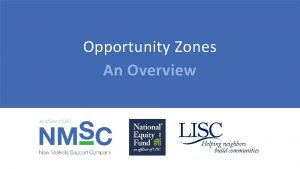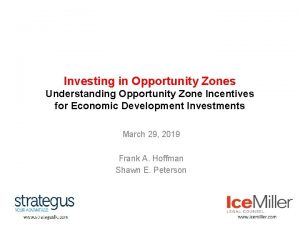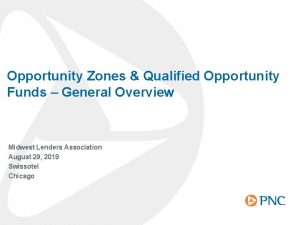Opportunity Zones Kenan Fikri Manager for Research and













- Slides: 13

Opportunity Zones Kenan Fikri, Manager for Research and Policy Development ECONOMIC INNOVATION GROUP / Washington, DC

The Opportunity Zones program was developed as an innovative, bipartisan solution to expand the geography of economic growth 2

The program is designed to help seed the next generation of enterprise in communities that desperately need it • The Opportunity Zones program was established by Congress in the 2017 Tax Cuts and Jobs Act to spur long-term private sector investments in low-income communities nationwide. • This new economic development program offers a frictionless way for investors to reinvest unrealized capital gains into distressed communities through Opportunity Funds, in exchange for a graduated series of incentives tied to long-term holdings. • This program is the first new national community investment program in over 15 years and has the potential to be the largest economic development program in the U. S. 3

What it is, what it isn’t A few important things to keep in mind before we dive into the specifics: • This is an investor incentive, not one that is awarded to individual companies. • All incentives pertain to capital gains—present and future—not operating revenue or costs. • In only rare instances will this appeal to, or even be available for, an established company looking to site a new facility. • There are no up-front appropriations. • The program is market-based—investors will determine how large or small it eventually becomes by how many investable opportunities they identify. • This is a new type of incentive that will attract a different type of investor. It is a novel tool in the economic developer’s toolbox, and accordingly it will force some new thinking in order to get right. • Capital is not a panacea. States and localities are still on the hook for education and training, nurturing startup ecosystems, and other complementary factors that will determine whether this program achieves its maximum potential. 4

How do Opportunity Zones work? The Opportunity Zones program offers investors three incentives for putting some of their $6 trillion in unrealized capital gains to work rebuilding economically distressed communities: 1. A temporary deferral: An investor can defer capital gains taxes until 2026 by putting and keeping unrealized gains in an Opportunity Fund. 2. A reduction: The original amount of capital gains on which an investor has to pay deferred taxes is reduced by 10% if the Opportunity Fund investment is held for 5 years and another 5% if held for 7 years. 3. An exemption: Any capital gains on investments made through the Opportunity Fund accrue tax-free as long as the investor holds them for at least 10 years. 5

How do Opportunity Zones work? Comparison of Investing in an O-Fund vs. a Standard Stock Portfolio: Scenario: A Capital Gain of $100 is Reinvested in 2018 Incentives Offered by the Opportunity Zones Program Deferral + 10% step-up in basis Deferral + additional 5% step-up in basis Deferral + total 15% step-up in basis + permanent exclusion of O-Fund gains from taxes After-Tax Value of Investment $200 + $44 + $15 $100 + $9 $100 It takes five years for a standard investment to recoup capital gains taxes paid in 2018 $111 $132 $0 5 years Standard Portfolio Investment 7 years Holding Period 10 years Excess Returns Offered by an O-Fund Investment 6

What are Opportunity Funds? • Opportunity Funds (O-Funds) are investment vehicles organized as corporations or partnerships that hold at least 90% of their assets in qualified opportunity zone business property. • There are three types of business property eligible for investment: • Original-issue stock of a qualified opportunity zone corporation. • Interest in a qualified opportunity zone partnership. • Tangible property used in qualified opportunity zones. • In laymen’s terms, that means just about any asset: high-growth startups, main street businesses, real estate, manufacturing facilities, brownfield redevelopment, entrepreneurship incubators and accelerators, co-working spaces, rental housing, and more. • So-called “sin” businesses such as casinos, massage parlors, and golf courses are excluded. • Who? Institutional investors and investment banks, impact investors, CDFIs, multifamily offices, philanthropies, venture capital partnerships, angel groups, and more should all be interested in investing in or establishing their own Opportunity Funds. • Localities may be able to set up their own funds as well. 7

How do Opportunity Zones get designated? • Governors of every U. S. state and territory can nominate up to 25 percent of their low-income/highpoverty census tracts as Opportunity Zones. About 40 percent of the average state’s census tracts are therefore eligible to be nominated. • Governors have 90 days from enactment (ending March 21, 2018) to submit their nominations to the U. S. Treasury Secretary and may request a 30 -day extension. • Governors are given broad discretion when it comes to designating zones that meet the basic criteria, although they should consult with local leaders. Congress also advised governors to give preference to areas that: 1. Are the focus of mutually-reinforcing state, local, and private development initiatives. 2. Have demonstrated past success in utilizing programs such as NMTC, Enterprise Zones, or Promise Zones. 3. Suffered major recent job losses from plant closures or relocations. • Nominations should balance need and opportunity, given that this market-based incentive does not guarantee investment. Absorptive capacity, connectivity, and ecosystem support assets should all be taken into consideration. • Best practice would weight factors such as proximity to research universities, for example, heavily too. 8

How do Opportunity Zones differ from other geographically-targeted community investment programs? The Opportunity Zones program incorporates lessons learned and builds on past place-based economic development incentives in several ways: • All incentives pertain to capital gains, tapping into resources that were previously on the sidelines of economic development. • It is targeted: By narrowing the number of Low-Income Community census tracts that are eligible, the program concentrates capital where other programs spread it too thinly. • It is simple: After meeting basic qualifications, investors and businesses face none of the micromanagement that limited the uptake of past programs. • It is flexible: The program is specifically designed to foster various types of investment. • It provides no up-front subsidy and doesn’t pick winners: Funds and investors make their own decisions. • It rewards patient capital: All incentives are tied to the longevity of the investment. • It is designed more for startups than incumbents. • It is scalable: With no cap from appropriations, the program can scale to match investor demand. • It gives investors a stake in communities’ future: Most programs reward individual projects; this one ties investor payoff to community success. 9

How might Opportunity Zones manifest themselves on the ground? Entrepreneurship Innovation Districts/ TOD Brownfield Redevelopment 10

There are three stages of next steps 1. Zone Designation (immediate) • Work with your state counterparts to provide local market intelligence so that your region’s highest priority, opportunity, and need census tracts get included in your state’s nominations. Hold your state elected representative to account for holding bottom-up consultations. 2. Setting up Funds (2018) • Raise awareness about the program among local banks, financial institutions, investors, and business networks to encourage the establishment of Opportunity Funds specializing in your state or region. • Think about whether and how you and your partners should establish an Opportunity Fund for your region. 3. Facilitating investment (on-going) • Raise awareness about the program now with local entrepreneurs and high-growth companies that may be eligible for investment from Opportunity Funds. • Work with universities, startup incubators and accelerators, and other ecosystem partners to ready your home region to take advantage of the program. • Work with local planners and developers to determine how this new financing model can integrate with existing or anticipated development or infrastructure plans. • Liaise actively with local, regional, and national funds to make sure they are aware of eligible investment opportunities in your region. 11

Resources • Economic Innovation Group: eig. org/opportunityzones • Enterprise Community Partners: https: //www. enterprisecommunity. org • Novogradac & Company: https: //www. novoco. com/resource-centers/opportunity-zone-resourcecenter • U. S. Treasury: https: //www. cdfifund. gov/pages/opportunity-zones. aspx • Colorado OEDIT: https: //choosecolorado. com/oz • Impact Alpha: https: //news. impactalpha. com/john-lettieri-and-steve-glickman-turning-capital-gainsinto-community-investments-4 b 00889 f 2579 12

EIG brings together leading entrepreneurs, investors, economists, and policymakers from across the political spectrum to address America’s economic challenges. WEB eig. org EMAIL info@eig. org facebook. com/Economic. Innovation. Group linkedin. com/company/economic-innovation-group twitter. com/Innovate. Economy
 Kenan fikri
Kenan fikri Weather and climate video
Weather and climate video How do littoral zones differ from riparian zones?
How do littoral zones differ from riparian zones? Opportunity assessment plan sample
Opportunity assessment plan sample Ashton nine types of leader download
Ashton nine types of leader download Opportunity zones nevada
Opportunity zones nevada Ana düşünce nedir
Ana düşünce nedir Fikri plan
Fikri plan Fikri ve sınai mülkiyet hakları teknoloji tasarım
Fikri ve sınai mülkiyet hakları teknoloji tasarım Aldosteron pra oranı
Aldosteron pra oranı Basit problemler
Basit problemler Kenan ocak çevre ve şehircilik
Kenan ocak çevre ve şehircilik Kenan flagler cover letter template
Kenan flagler cover letter template Kenan dolapçıoğlu instagram
Kenan dolapçıoğlu instagram
